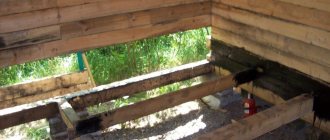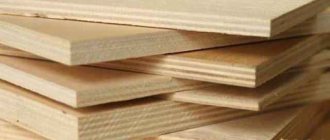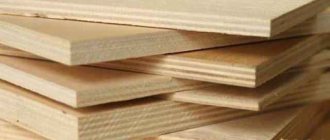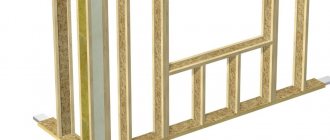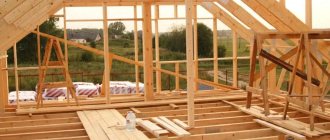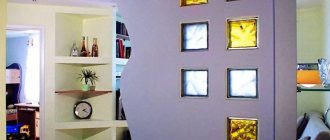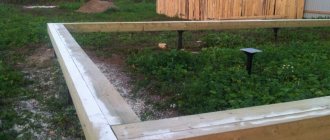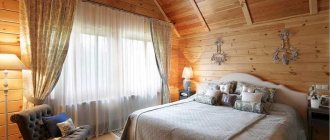If a project to build a house or renovate a city apartment involves wooden floors, then the contractor will be faced with the issue of choosing lumber. Not every novice craftsman knows which timber to use for floor joists. After all, logs are the support of the floor structure, which will be affected by all loads, from the floor covering to furniture and people. Therefore, the most important condition for constructing a floor is to ensure its long-term operation, based on the high strength characteristics of the materials used. As for the logs, first of all they are selected according to the cross-section on which the strength of the beam depends, and according to the laying step between them.
If you choose the right parameters of the timber, you can save a lot of money on construction activities related to the construction of the floor structure. And although today manufacturers offer logs made of plastic, reinforced concrete and metal, wood remains a popular material, which is cheaper than all the others.
Advantages of wooden logs
In addition to the low price, wooden logs have other advantages.
- Installation is carried out manually without the use of special equipment and complex mechanisms. This again affects cost savings during the construction or renovation process.
- Utility lines can be installed in the space between the lags.
- The insulation is also installed here. Depending on the thickness of the thermal insulation layer, the logs are selected according to their width.
- Wooden beams are a lightweight material, so they do not exert significant loads on the load-bearing structures of the building.
A special case
Sometimes timber can be used not only for making beams, but also as a finishing coating. Timber floors are assembled in institutions with strict acoustic requirements and high traffic volumes: conservatories, theaters, etc.
The connection method is the already familiar tongue and groove method; The main disadvantage of the solution is its high cost. A 10 cm thick laminated timber floor will cost approximately 3,000 rubles per square meter without the cost of work.
Tongue-and-groove floor timber. Material: spruce.
Criteria for choosing wooden blocks for joists
Much will depend on where the joist structure will be assembled. There are several options here, these include floors on the ground, on a concrete base, and on the foundation, when the logs are installed in a canopy. Based on this, the section of the beam is selected, of course, taking into account the distance between the installed elements.
For example, if floors are constructed in a city apartment on a concrete screed, then there are no strict requirements for the size of the bars. The main thing here is to comply with the parameters of the ceiling height, and if necessary, then the parameters of the insulation. If a wooden floor is installed on the ground floor, then the minimum width of the bars used should be 70 mm, because this is the thickness of the insulation that will ensure good thermal insulation of the apartment. In this case, the bars are laid on the edge, that is, on the smaller side of the section, which means that the width of the lumber will be the height of the joist structure.
As for the thickness of the timber, the optimal ratio to its width is 1:2. Since in the example the width parameter of 70 mm was chosen, the thickness of the bar will be either 35 or 40 mm. In this case, the thickness determines the stability of the installation. And the larger it is, the stronger the lag will stay on the surface. But this increases the cost of the product. Therefore, it is necessary to choose the optimal option for the aspect ratio of the beam section.
When constructing a floor in an apartment that is not on the first floor, you do not need to use the standard section aspect ratio. Here you can choose any timber, because the logs are laid on the same concrete floor only without a heat-insulating layer, the dimensions of which are no longer taken into account. These can be bars with a cross section of 40x40, 40x50, 50x50 mm. In this case, the smaller the size of the log height, the higher the ceiling after the construction of the wooden floor.
Stages of building a floor in a timber house
Developers are offered many options for arranging floors; they should choose a specific one at the design stage. This will prevent mistakes and violations of building codes and regulations. In this way, it will be possible to install reliable and durable floors.
You need to decide on the type of floor in advance
Table. What types of floors are used in log houses?
| Floor type | Brief description of performance characteristics |
| Heated | Relatively new and quite fashionable flooring options. Heating the room at zero level is the most profitable option from both an economic and operational point of view. If warm air rises from the floor, then the entire volume of the room is optimally heated, and the most favorable temperature is located at the level of 1.5 m, and not under the ceiling. This makes it possible to save significant financial resources during the heating season. The coolant can be water or electricity. But, unfortunately, it is strictly not recommended to install heated floors in houses made of timber. Why? Firstly, in wooden houses the best finishing option is natural boards, this is natural. And they conduct heat very poorly, as a result of which the efficiency of using coolants is significantly reduced, and all the advantages of bottom heating are eliminated. It is not practical to make floors in wooden houses from ceramic tiles or other coatings with high thermal conductivity. They have a very large weight, they are afraid of fluctuations in linear dimensions, and cobblestone buildings are sure to have them. Secondly, if the floor water heating circuit leaks, the consequences for wooden structures are extremely negative. Thirdly, in the event of a short circuit, the likelihood of the structure catching fire increases. |
| Insulated | The most optimal option for arranging floors in wooden houses. Mineral wool is used as insulation; using polystyrene foam is not recommended. The floor has several separate elements, each of which performs its own functions. When installing these floors, it is very important to ensure effective natural ventilation of the underground space. Otherwise, the tree is damp and quickly becomes susceptible to fungus and rot. In terms of operational parameters, insulated floors meet the requirements of developers and regulations on heat conservation of buildings. |
| Cold | For use only in non-residential or technical premises. It has a simple device, various options for finishing floor coverings are possible. Can be installed without a subfloor. |
How to make a floor in a house from timber
There are often situations when in one house made of timber there are several types of floors. As an example, we will consider the option of making an insulated floor on wooden logs.
Lag structure on load-bearing beams
The construction of floors using load-bearing beams is common in private housing construction. It is also used to construct building floors and, if necessary, to form floors with a ventilated underground. In this case, the logs are attached to the installed beams only at their ends. The same design is used when constructing the floor of small rooms on the ground floor, when the logs are installed with their ends on the foundation.
In this case, the choice of bars, or rather the choice of their cross-section, depends on the length of the lumber. The longer the beam, the larger its cross-section should be. Here are the recommended values for this ratio.
- The length of the log is 3 m - the section of the timber is 150x80 mm.
- Length 3-4 m – section 180x100 mm.
- 4-5 m – 200x150 mm.
- More than 5 m – 220x180 mm.
If the structure is installed on the ground floor with the installation of logs along the foundations, then the indicated dimensions can be reduced by constructing intermediate racks made of brick, pipes or concrete. But with this arrangement, the distance from the lower edges of the joists to the ground is taken into account. It should not exceed half a meter. If this indicator is greater, then the beams are installed without support posts. This means you will have to purchase lumber in sizes from the list described above.
Distance between joist elements
Logs are a support for the flooring, plus everything that will be placed on the floor: furniture, household appliances, musical instruments, etc. These are static loads. There are dynamic ones, which include the movement of people and pets. Both loads must be taken into account when choosing the distance between the lags. It is difficult to do this at the construction stage, because it is not yet known what furniture and in what quantity will be installed in the room.
Therefore, it is recommended to use the thickness of the flooring as a basis for calculating the lag spacing. For example, if it is plywood or OSB boards, then their small thickness (16-22 mm) determines the minimum step - 30 cm. As for floorboards, everything will depend on their thickness.
- If the thickness of the board is 20-25 mm, then the distance between the logs is set within 30 cm.
- If boards with a thickness of 30-35 mm are selected, then the installation step will be within 50-60 cm.
- Accordingly, 40-45 mm – 70-80 cm.
- 50 mm – distance within 1 m or more.
It should be noted that the pitch of laying the logs is the distance between the middles of the bars along the longitudinal axis, and not between the edges of the elements. From the calculation of this parameter, the number of required beams for the logs is also calculated. In this case, one technological point is also taken into account - the distance from the walls to the outer elements of the floor structure is 25 cm.
Attaching the floor board
An example of laying a tongue and groove board using a clamp and wedges.
So, all you have to do is attach the floor board to the joists. Here you need to follow some recommendations and then your wooden floor will be reliable, strong and stable under maximum load.
- Boards are attached to wooden beams using nails, the length of which is twice the width of the board.
- Before you start laying the boards, you need to prepare holes for fasteners by drilling. It is important to make the holes 1-2 mm smaller than the thickness of the nail. This will prevent the floorboard from splitting.
- Ideally, the length of the boards will clearly fit into the parameters of your room and you will not have to splice the floorboards. But if, nevertheless, it was not possible to find a board of the required length, then the two boards need to be joined directly on one of the floors. This will prevent the floorboard from bending over time.
- It is necessary to attach floor boards to all joists.
- The finished floor covering must be treated with a special varnish or drying oil.
- We cover the joints between the wall and the floor with a beautiful wooden plinth or batten.
Important: the boards can be secured to the beams with self-tapping screws either at an angle of 45 degrees, or with subsequent treatment of the caps with a special sealant. And when laying floor boards, do not forget to leave 1 cm between the walls and the floor covering.
Wood moisture content
Dry wood is the key to high quality and long-term operation of a wooden structure. Therefore, builders recommend using bars with a humidity of no more than 20%, preferably within 12%, for the construction of a joist structure. In construction stores, all lumber is sorted according to this indicator. But there is no guarantee that this is true, because storage conditions in stores are sometimes violated. This means that the actual humidity of the purchased timber may not coincide with the passport value.
You can accurately determine the moisture content of lumber using a special device called an electric moisture meter. This is a device with two pins protruding from the body. They need to be stuck into the wood being tested. The display shows the humidity values. Everything is quite simple if you have this device in stock.
There is another way. To do this, a piece is cut from the block with a saw, which must be weighed. Then it is placed in an oven preheated to +100C and dried for an hour. The dried piece is weighed again. Now we need to do some math:
- The second value is subtracted from the first weight.
- The result obtained must be divided by the final (second) weight.
- The resulting number is multiplied by 100%.
- This results in the moisture content of the lumber.
All this, of course, is accurate, but difficult. Therefore, craftsmen have long used purely visual criteria for determining the moisture content of wood. For example, you can run a chemical pencil along the cut. If the line turns bright purple, then the humidity is high. And vice versa.
Humidity is also determined by chips. In dry wood it is brittle, in wet wood it is elastic, bends well and does not break. You can knock on the beam with a metal object. If the sound is dull, it means the humidity is high. If it is sonorous, then it is low. Coniferous wood releases resin when processed. If you press it with your finger and it crumbles under pressure, then you can talk about dry lumber.
Wood for logs
Since logs must withstand heavy loads, and at the same time not change their qualities and dimensions under the influence of changes in temperature and humidity, timber made from softwood is most often used as them. Deciduous trees have less bending strength. Namely, the logs are subjected to these loads. Although there are no strict restrictions in this regard.
Everything will depend on the budget for construction and repairs or the location of the floor. As a budget option, these are bars made of spruce or pine. But it is better not to use them in damp rooms, where the wood will be exposed to the negative effects of moisture. Under its influence, the lumber will begin to warp and change its parameters, which will lead to the formation of gaps between the floorboards, lifting of part of the flooring and other types of defects.
More durable materials, such as larch, will withstand any load, but such wood is expensive, which will lead to an increase in the construction budget. But such logs, even in a bathhouse, will last for decades, which will cover the initial costs of their purchase. In addition, larch contains a large amount of resin inside. Therefore, bugs and other harmful insects do not touch it.
Today, manufacturers offer various easy-to-install devices that determine the speed and quality of lag installation. And if the traditional installation option is logs secured with wooden bosses to the base floor surface or nails to load-bearing beams (sometimes additional fastening is done using binding wire), then the modern approach is special fasteners.
One of the varieties is metal fasteners in the form of profiles of various shapes. These are perforated parts with which the logs are attached to the load-bearing structures of the building. The photo below shows how the logs are attached to the concrete base with metal corners.
Another type is adjustable supports made of metal or plastic. The supports themselves are attached to the base with anchors or screws, and the beams are installed on their structure. In this case, the logs can be raised or lowered by rotating the threaded connection of the supports.
Requirements
Wood used for the manufacture of laminated laminated beams must meet certain requirements, including :
strength (the ability of a material to withstand various loads);- rigidity (material resistance to bending);
- fire safety (wood treatment with special fire-resistant compounds);
- heat and sound insulation.
The requirements must be strictly followed. Otherwise, the stability of the building may suffer, that is, it will be dangerous to be in such a building.
Reviews
Oleg, 34 years old, Novosibirsk
When building the bathhouse, I first used pine logs. At the beginning of construction, we had to save every penny; the family budget did not allow us to splurge on quality material. The savings turned out to be imaginary. Firstly, I forgot to treat the logs with an antiseptic, which ultimately led to the formation of mold. Although ventilation was installed in the floor. Secondly, as it turned out, the moisture content of the wood was high. The masters explained this to me later. That's why there were lags. Three years later, a hand fit into the gap. I had to lift the floors completely and throw out both the boards and joists. After which I purchased timber from Siberian larch. It is difficult to work with, it is very durable, nails cannot be driven in, but the structure is durable. So it is not recommended to save on lags. It’s better to invest a little more money, but be sure that the bathhouse will last a long time.
Alexander Surkov, 28 years old, Izhevsk
I got an apartment in a new building and decided to install plank floors in it. This is where I had to suffer, because the construction of the logs is directly related to the selection of the beam according to its cross-section. Due to inexperience, I purchased 100x50 mm bars and installed them at a height of 100. As it turned out, I did it wrong, and the ceiling height decreased sharply. Then I placed them on edge 50. The height became normal, but why did I need such a width of the joists, since the expected loads in the room were small. It turns out I just overpaid. So think first and then buy.
Maria Sergeevna, 52 years old, Nizhny Tagil
During the construction of the dacha, we chose a project where the floors are installed along joists. The project specified floors made of 50 mm boards. We decided to use OSB. And here we miscalculated the distance between the lags. We used a design value of 85 cm, but the slab bent under the weight of a person. Therefore, I had to add lags between those already installed.
